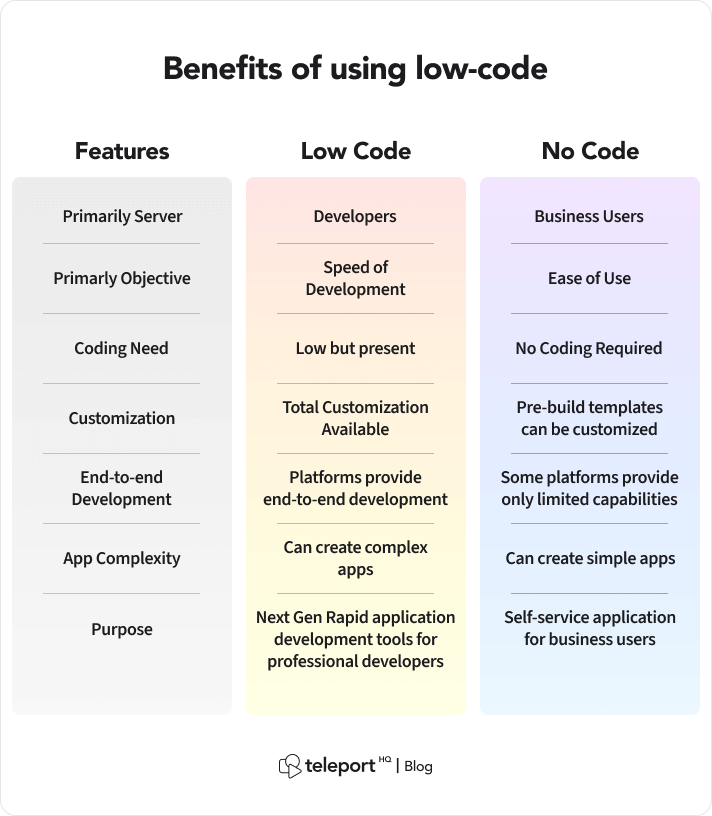Low-code applications greatly improve accessibility for non-developers. Often, they are referred to as "citizen developers," because of a variety of key aspects: Intuitive visual interfaces:
Drag-and Drop Builders: Low-code platforms come with drag-and-drop interfaces that let non-developers develop applications without needing to write any code. This makes the process of development more accessible to people who have little or no technical knowledge.
WYSIWYG editors Editors that use WYSIWYG: These "What You See is What You Get" editors allow users to build interfaces and workflows that are identical to the final product. This makes it simpler to use and understand.
Simplified logic and Workflow Design
Visual Workflow Design: Users are able to easily design business process and application logic with diagrams, flowcharts and models. They are much easier to work with than traditional coding.
Pre-built Logic components: Low-code platforms include logic components that are pre-built (e.g. conditional statements and loops), which can be configured easily, reducing the requirement for complex coding.
Reusable Components and Templates
Library of Pre-built Templats A lot of Low-Code platforms provide templates based on common application types. Developers who are not developers will be in a position to modify these templates, if required.
Reusable widgets and Modules by using modular or reusable widgets users can speed up the creation process, by reducing the requirement for detailed technical know-how.
Tutorials and guide development:
Step-byStep Guides: Platforms will often offer guided development paths, online tutorials, or on-screen instructions to assist users who aren't developers to create applications.
Interactive Tutorials - Interactive tutorials which let you interact with the platform can assist you in learning and build confidence.
Integration with Existing tools
Easy Integration - Low-code platforms can be easily integrated with existing systems and tools for business (e.g. ERP CRM) which gives even non-developers the ability to create apps that fit within their workflows.
APIs/Connectors: The built-in APIs/connectors enable non-developers to connect their apps to external services.
Collaboration Features:
Team Collaboration - Features such as real-time team collaboration, and shared workspaces enable non-developers to collaborate effectively with professionals, developers, analysts and other the other stakeholders.
Access levels are able to be set for non-developers to make sure they are able to contribute to the development process, but without compromising security.
Automated Testing and Debugging
Built-In Testing Tools: Platforms that are low-code usually come with built-in testing and debugging tools that automate these processes, making it easier for non-developers to ensure their applications work correctly.
Error Highlighting When problems occur the platform highlights these and suggests solutions. It helps non-developers in troubleshooting.
The main benefit of low-code application development for accessibility for non-developers is in its ability to democratize the development process. Low-code platforms allow business users to be involved in the development and maintenance of apps by offering visual tools as well as a guiding user experience. This helps bridge the gap between business and technical needs. Have a look at the most popular Low-code Platform for application development for website examples including build with docker, sso azure, develop cross platform mobile app, app modernisation, application modernization, low code development platforms, software for app development, rapid application design, rapid app development, cross platform app dev and more.

The Cost-Effectiveness Of Low-Code Development Is Among The Major Benefits.
Low-code applications offer a variety of advantages when it comes to cost-effectiveness. Businesses looking to optimize budgets are able to benefit from this method while still delivering high-quality applications. These are the major benefits reduced development costs:
A lower code platform reduces the need for lengthy manual coding. This saves time and effort of developers when creating applications. The result is lower labour costs.
We need fewer developers: Development that is low-code takes shorter time, and it is easier. This means that less developers are needed. It could reduce the cost of hiring and staffing.
More Time to Market
Accelerated Development: Low-code platforms provide visually-based development tools, components that are pre-built and other tools that allow rapid development of applications. Businesses can bring their products on the market more quickly. This will result in faster revenue growth and improve your position in the marketplace.
Rapid prototyping: By developing and testing prototypes in a short time companies can decrease the time they devote to the development stage and enable faster revisions based on user feedback.
Lower Maintenance Costs
Due to their modularity and standard components, apps built on low-code platforms tend to be easier to maintain. This will reduce the cost of maintenance and ongoing support.
Automated Patches and Updates Low-code platforms can manage patching and updating applications automatically. This means that the application is secure and always up to date without requiring a lot of manual effort.
Efficient Resource Utilization:
Non-Developer contributions: Low code platforms enable non-developers such as business users, to participate in the process of development. This democratization of development allows businesses to leverage the skills of a wider variety of employees, thus reducing dependence on developers who are highly paid.
Utilizing IT resources efficiently IT departments get the chance to concentrate on more strategic initiatives, instead of getting bogged down with mundane development tasks. Overall efficiency and productivity are improved.
Scalable Pricing Models:
Subscription-Based Price: Many low code platforms offer flexible subscription-based pricing that scales with the amount of usage. This enables businesses to make sure that their budget is in line with their actual needs and increase.
Pay-Asyou-Go Options Certain platforms allow businesses to pay only for the services they use. This is particularly useful for startups or small companies with limited funds.
Reduce the cost of third-party software:
Built-in Functionalities: Low-code platforms come with many built-in features and integrations, which make it less necessary to use third-party tools and software. Subscription fees and licensing costs are also cut down.
Pre-Built Integrates by integrating well-known services and systems, you can save time and money by avoiding the requirement to create custom integrations.
Increased ROI:
Faster Return On Investment: A combination of rapid development and lower costs, coupled with a faster time to marketing will allow businesses to earn greater return on investment.
Increased Ability. Businesses can quickly adapt changing market conditions and requirements of customers, ensuring they remain relevant. They also can profit from new business opportunities when they arise.
Costs of training are lower:
Low-Code platforms have user-friendly interfaces. The simple and user-friendly interfaces reduce the learning curve of novice users. This eliminates the requirement for extensive training programs.
Accessible resources: Many low-code platforms have complete tutorials, instructional materials, and community assistance, reducing the requirement for formal education.
Collaboration Streamlined:
Enhance Collaboration Tool The built-in collaboration tool facilitates better communication and cooperation among team members. This leads to faster development processes and decreases the project's overhead.
Unified Development Environment : A unified environment simplifies work flows and lowers the cost that are associated with managing different platforms and tools.
The overall cost-effectiveness of low-code application development stems from its ability to reduce the cost of development and maintenance as well as speed up the time to market, improve utilization of resources, as well as provide flexibility in pricing. All of these factors provide significant financial benefits for businesses, making low-code a compelling choice for organizations aiming to maximize their development budgets while achieving high-quality, flexible high-quality and robust applications. Check out the recommended Enterprise application development with Low-code Platform examples for site advice including cross platform mobile dev, application modernisation, app development platform, app development platform, azure sql, push notifications, azure sql, app platforms, app modernization, app dev platform and more.

Advantages Of Low-Code Application Development In Terms Of Vendor Support And Community
Low-code platform development provides significant advantages, including support from vendors and a community support. This is crucial to ensuring successful application implementation, ongoing maintenance and continuous improvement. Here are a few major benefits: Support from vendors
Comprehensive Technical Support:
Support Team with Dedicated Staff: Many low code platforms have dedicated support staff that are on hand to assist with technical queries in troubleshooting and advice. They will ensure that issues are resolved promptly.
Certain vendors offer support 24 hours a day. This can be very useful for companies that operate across time zones.
Onboarding and Training:
Structured Training: A lot of vendors offer structured training, including webinars, tutorials and certification courses that help users quickly become comfortable with the platform.
Personalized Onboarding: Many companies offer personalized onboarding services to help new customers use the platform efficiently and adapt it to their specific needs.
Regular updates and enhancements
Continuous Improvement: Low-code platforms release regular updates, which include new features, security patches and enhancements to performance. This makes sure that the platform is always current and safe.
Feedback Integration Vendors incorporate customer feedback into the development process and ensure that the platform is updated to meet changing needs.
Comprehensive Documentation:
Documentation is detailed: Users are usually able to access a wealth of well-organized documents that range in complexity from simple modification to advanced.
API References Detailed API documentation allows developers to customize applications and integrate low-code platforms with other systems.
Professional Services and Consulting
Expert Consultation : Vendors provide consultancy services, including designing architecture and complex implementations. They provide this service in order to make sure that their users are able fully benefit from the platform.
Custom Development Services A few companies offer custom development services to build specific integrations and features that aren't available in the standard.
Community Support for the Community
Active User Groups:
Forums and Discussion Boards: Many low-code platforms have vibrant online communities in which users can seek answers, discuss solutions, and work together on the best practices.
Virtual and local User Groups: These groups give you the chance to connect, share knowledge and share experiences.
Knowledge sharing and collaboration
Community-Contributed Resources: Users often share templates, modules, and extensions that they have developed, which can be reused or adapted by others, accelerating development and innovation.
Crowdsourced problem solving The collective knowledge and experience of the community is an invaluable resource for troubleshooting problems and coming up with inventive solutions.
Learning and Development
Community-led training A lot of community groups offer training sessions, webinars and workshops led by experts who have experience in the area.
Online Courses and Tutorials Community members often create and share online courses, tutorials, and how-to guides, improving the resources for learning accessible to all users.
Feedback and Influence:
Forums for Product Feedback: These forums often provide feedback to the manufacturer that can affect the creation of new features and enhancements.
Beta Testing members of active communities may have an opportunity to take part. This allows them to get early access to the platform and participate in the development of the platform.
Recognition and support:
Community Recognition Programs: A lot of vendors have recognition programs that acknowledge the contributions of community members who are active for example, MVP (Most Valuable Professional) programs.
Peer Support : Community members offer support to other peers, sharing their experience and offering guidance. They create a collaborative and supportive environment by sharing their knowledge.
Overall, the combination of strong vendor support and active, engaged communities that provide a complete environment for the assistance with low-code development of applications. Users will be able gain access to the experts, resources and collaboration opportunities that they need to develop, deploy, maintain and further enhance their apps.
